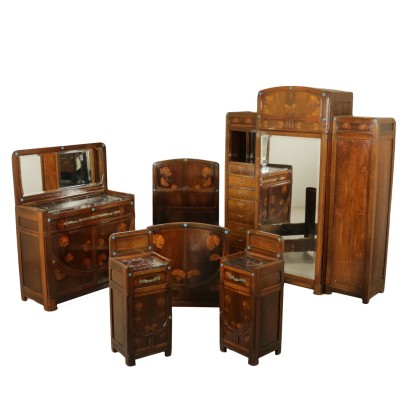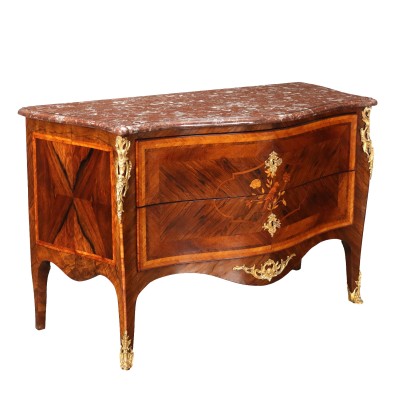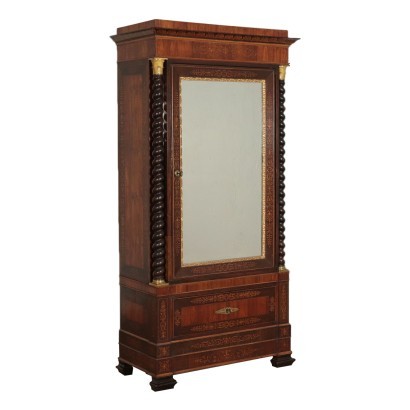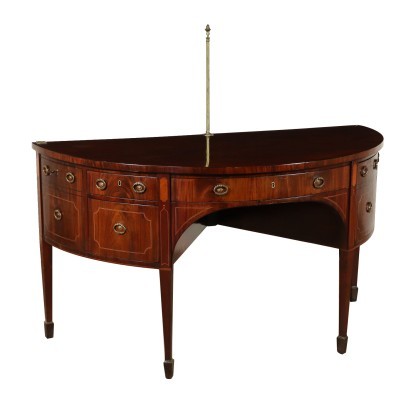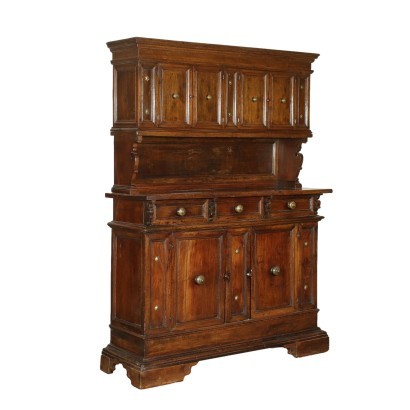The room attributable to the E. Quarters
Features
Style: Art Nouveau (1890-1920)
Age: 20th Century / 1901 - 2000
Year: 1910 ca.
Origin: Italy
Main essence: Brazilian Rosewood , Mahogany , Walnut
Material: Maple Veneer , Brazilian Rosewood Veneer , Brass
Description
The furniture, from the line slightly moved, presents an architectural structure to members of the sinuous curves and customize the front, the drawers and doors. Refined panels to the arches characterize the doors and the drawers in a continuum of stylistic enriched by thin filettaure brass floral inlays in mahogany and the application of lacquers in shades of light blue round thread rolling. Veneered in rosewood from rio on the whole surface, has elegant brass handles. Drawers in walnut, shaped in the corners. Interior veneered in birdseye maple with frames in mahogany, recalling the shaping of the main panels. Furniture consists of large wardrobe, eight drawers and an open compartment with a mirror. Pair of doors of which the central mirror and bevelled. Single bed shaped, pair of bedside tables with upstand and flat marble sunken. A chest with raised mirror, two doors on the front with small drawers inside and shelves of marble set.
Product Condition:
Product in good condition, has small signs of wear and tear.
Additional Information
Style: Art Nouveau (1890-1920)
Historical stylistic period formed from the end of the 19th century (ca. 1890) after the Umbertino style and continued until the First World War.The current was characterized by the floral influence and the soft and curved lines, typical example are the "whiplashes".
The first signs of this new era came from architects such as Hector Guimard (1867-1942) who created numerous buildings and hotels, but also from people such as Arthur Mackmurdo furniture designer and Arthur Liberty industrialist and London merchant of the late 19th century who began to produce furnishing fabrics with floral motifs with soft and sinuous shapes.
The Universal Exhibition of Paris in 1900 was an important point for the development and affirmation of Liberty in the following decade.
Liberty was called in different ways depending on the nation, universally known as Art-Nouveau and it is thought that Arthur Liberty is the origin of the name given in Italy to this beautiful stylistic movement.
The name Art-Nouveau is thought to derive from a shop located in Paris called Maison de l'Art Nouveau which began to show off furniture with a new and innovative design in its windows.
With the end of the First World War, the naturalistic period of Liberty ended and the Art-Decò style appeared, with more rigid and geometric lines.
Find out more about the Liberty style with our insights:
Art Nouveau: birth and development of a style
Milan Liberty between flowers and colors
Carlo Zen's Liberty
Decorative shapes and elegance in an Liberty living room
FineArt: Aeolus and Cupid, Liberty sculpture by Luca Madrassi
FineArt: Nymph and Faun, Liberty sculpture by Giuseppe Siccardi
The Austrian taste of Baroque

